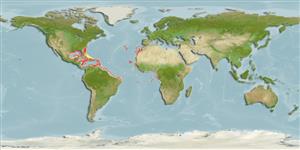分类 / Names
俗名 | 同种异名 | Catalog of Fishes(属, 种) | ITIS | CoL | WoRMS | Cloffa
Teleostei >
Aulopiformes (Grinners) >
Ipnopidae (Deep-sea tripod fishes) > Ipnopinae
Etymology: Bathypterois: Greek, bathys = deep + Greek, pterois = with wings (Ref. 45335).
More on author: Günther.
Environment: milieu / climate zone / depth range / distribution range
生态学
海洋 深海底的; 深度上下限 402 - 1408 m (Ref. 3590). 深水域; 35°N - 10°S
Eastern Atlantic: Gulf of Guinea region. Western Atlantic: between 35° and 10°S, including the Gulf of Mexico and the Caribbean. Northwest Atlantic: Canada (Ref. 5951).
東大西洋: 幾內亞灣區域。 西大西洋: 在 35個 ° 與 10個 °S 之間, 包括墨西哥灣與加勒比海。
大小 / 重量 / 年龄
Maturity: Lm ? range ? - ? cm
Max length : 18.0 cm SL 雄鱼/尚未辨别雌雄; (Ref. 3590); common length : 14.0 cm SL 雄鱼/尚未辨别雌雄; (Ref. 3590)
背棘 (总数) : 0; 背的软条 (总数) : 14 - 15; 臀棘: 0; 臀鳍软条: 9 - 10. Outer 2 pelvic rays prolonged to reach origin of anal fin; lower caudal rays not prolonged; subcaudal notch present at base of lowermost caudal fin (Ref. 13608).
外部的 2个腹鳍鳍条延长达到臀鳍起点; 不被延长的下尾部的鳍条; 子尾部的凹槽出现在最低尾鳍的基底。 (参考文献 13608)
Synchronously hermaphroditic. Fecundity of 4,500 eggs for one specimen.
同步雌雄同体。 为一件标本的 4,500个卵的孕卵数。
Life cycle and mating behavior
Maturities | 繁殖 | Spawnings | Egg(s) | Fecundities | 仔鱼
東大西洋: 幾內亞灣區域。 西大西洋: 在 35個 ° 與 10個 °S 之間, 包括墨西哥灣與加勒比海。
Merrett, N.R., 1990. Chlorophthalmidae. p. 351-360. In J.C. Quero, J.C. Hureau, C. Karrer, A. Post and L. Saldanha (eds.) Check-list of the fishes of the eastern tropical Atlantic (CLOFETA). JNICT, Lisbon; SEI, Paris; and UNESCO, Paris. Vol. 1. (Ref. 3590)
人类利用
工具
特别资料
下载 XML
网络资源
Estimates based on models
Preferred temperature (Ref.
123201): 5.8 - 10.9, mean 7.5 °C (based on 126 cells).
Phylogenetic diversity index (Ref.
82804): PD
50 = 0.5000 [Uniqueness, from 0.5 = low to 2.0 = high].
Bayesian length-weight: a=0.00490 (0.00195 - 0.01230), b=3.03 (2.81 - 3.25), in cm total length, based on LWR estimates for this (Sub)family-body shape (Ref.
93245).
营养阶层 (Ref.
69278): 3.4 ±0.4 se; based on size and trophs of closest relatives
回复力 (Ref.
120179): 低的, 最小族群倍增时间4.5 - 14 年 (Preliminary K or Fecundity.).
Fishing Vulnerability (Ref.
59153): Low vulnerability (12 of 100).
